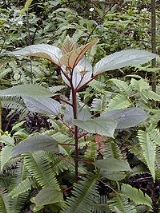
Pipturus albidus
Encyclopedia
Pipturus albidus, known as Māmaki (sometimes Waimea, for its resemblance to olomea
) in Hawaiian
, is a species of flowering plant
in the nettle
family, Urticaceae
, that is endemic to Hawaii
. It inhabits coastal mesic, mixed mesic, and wet forests at elevations of 60 –. Māmaki is a small tree
that reaches a height of 9 m (29.5 ft) and a trunk diameter of 0.3 m (0.984251968503937 ft).
made a treatment for illnesses known as ea and pāaoao from the fruit
. They also combined fresh māmaki leaves
with hot stones and spring water to produce an herbal tea that was an effective treatment for general debility. Today, packages of dried māmaki leaves are commercially produced.
s were used by Native Hawaiians to make kapa
(bark cloth) and kaula (rope
).
plant for the caterpillar
s of the Kamehameha butterfly (Vanessa tameamea). Māmaki sometimes host the caterpillars of the Green Hawaiian Blue (Udara
blackburni).
Perrottetia
Perrottetia is a genus of flowering plants in the family Dipentodontaceae. The fifteen species it contains occur in Asia from China to Australia, and in the Americas from Mexico to Peru.-Selected species:* Perrottetia excelsa Lund....
) in Hawaiian
Hawaiian language
The Hawaiian language is a Polynesian language that takes its name from Hawaii, the largest island in the tropical North Pacific archipelago where it developed. Hawaiian, along with English, is an official language of the state of Hawaii...
, is a species of flowering plant
Flowering plant
The flowering plants , also known as Angiospermae or Magnoliophyta, are the most diverse group of land plants. Angiosperms are seed-producing plants like the gymnosperms and can be distinguished from the gymnosperms by a series of synapomorphies...
in the nettle
Nettle
Nettles constitute between 24 and 39 species of flowering plants of the genus Urtica in the family Urticaceae, with a cosmopolitan though mainly temperate distribution. They are mostly herbaceous perennial plants, but some are annual and a few are shrubby...
family, Urticaceae
Urticaceae
Urticaceae, or the nettle family, is a family of flowering plants. The family name comes from the genus Urtica . Urticaceae includes a number of well-known and useful plants, including the aforementioned nettles, Ramie , māmaki , and ajlai .The family includes approximately 2600 species, grouped...
, that is endemic to Hawaii
Hawaii
Hawaii is the newest of the 50 U.S. states , and is the only U.S. state made up entirely of islands. It is the northernmost island group in Polynesia, occupying most of an archipelago in the central Pacific Ocean, southwest of the continental United States, southeast of Japan, and northeast of...
. It inhabits coastal mesic, mixed mesic, and wet forests at elevations of 60 –. Māmaki is a small tree
Tree
A tree is a perennial woody plant. It is most often defined as a woody plant that has many secondary branches supported clear of the ground on a single main stem or trunk with clear apical dominance. A minimum height specification at maturity is cited by some authors, varying from 3 m to...
that reaches a height of 9 m (29.5 ft) and a trunk diameter of 0.3 m (0.984251968503937 ft).
Medicinal
Native HawaiiansNative Hawaiians
Native Hawaiians refers to the indigenous Polynesian people of the Hawaiian Islands or their descendants. Native Hawaiians trace their ancestry back to the original Polynesian settlers of Hawaii.According to the U.S...
made a treatment for illnesses known as ea and pāaoao from the fruit
Fruit
In broad terms, a fruit is a structure of a plant that contains its seeds.The term has different meanings dependent on context. In non-technical usage, such as food preparation, fruit normally means the fleshy seed-associated structures of certain plants that are sweet and edible in the raw state,...
. They also combined fresh māmaki leaves
Leaf
A leaf is an organ of a vascular plant, as defined in botanical terms, and in particular in plant morphology. Foliage is a mass noun that refers to leaves as a feature of plants....
with hot stones and spring water to produce an herbal tea that was an effective treatment for general debility. Today, packages of dried māmaki leaves are commercially produced.
Non-medicinal
The bast fibreBast fibre
Bast fibre or skin fibre is plant fibre collected from the phloem or bast surrounding the stem of certain, mainly dicotyledonous, plants. They support the conductive cells of the phloem and provide strength to the stem...
s were used by Native Hawaiians to make kapa
Kapa
Kapa is a fabric that was made by Native Hawaiians from the bast fibres of certain species of trees and shrubs in the orders Rosales and Malvales. It is similar to tapa found elsewhere in Polynesia but differs in the methods used in its creation...
(bark cloth) and kaula (rope
Rope
A rope is a length of fibres, twisted or braided together to improve strength for pulling and connecting. It has tensile strength but is too flexible to provide compressive strength...
).
Ecology
P. albidus is the preferred hostHost (biology)
In biology, a host is an organism that harbors a parasite, or a mutual or commensal symbiont, typically providing nourishment and shelter. In botany, a host plant is one that supplies food resources and substrate for certain insects or other fauna...
plant for the caterpillar
Caterpillar
Caterpillars are the larval form of members of the order Lepidoptera . They are mostly herbivorous in food habit, although some species are insectivorous. Caterpillars are voracious feeders and many of them are considered to be pests in agriculture...
s of the Kamehameha butterfly (Vanessa tameamea). Māmaki sometimes host the caterpillars of the Green Hawaiian Blue (Udara
Udara
Udara is a genus of butterflies in the family Lycaenidae.-Species:*Subgenus Udara Toxopeus, 1922** Udara akasa - White Hedge Blue ** Udara aristinus ** Udara aristius...
blackburni).

